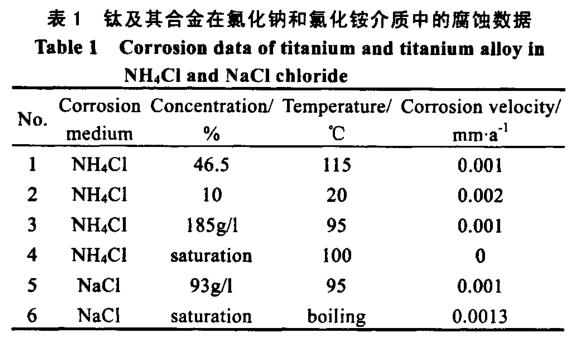1. Introduction
Titanium and its alloys exhibit excellent corrosion resistance in acids, alkalis, and salts, along with advantages such as lightweight and high specific strength. These properties have led to their widespread use in industries including chemical, petroleum, metallurgy, power, and marine engineering.
Despite higher material costs, titanium offers significant economic benefits due to its lifecycle durability, strength, and environmental advantages. With a density approximately 50% of copper and 57% of 1Cr18Ni9Ti stainless steel, titanium reduces equipment weight by half compared to steel or copper. Its high specific strength further enhances lightweight design. Titanium equipment also extends service life, improves product quality, reduces maintenance costs, and enhances labor conditions. This article reviews the application of titanium equipment across industries and current manufacturing technologies, addressing challenges and proposing solutions.
2. Application Overview of Titanium Equipment
2.1 Chemical Industry
Industrialized nations spend 3–4% of GDP on corrosion protection annually. Titanium’s strength, corrosion resistance, and thermal conductivity make it indispensable in chemical production.
2.1.1 Soda Ash Industry
Ammonia-soda or combined alkali processes expose equipment to aggressive media like NaCl and NH₄Cl. Titanium’s corrosion rate in NH₄Cl solutions is 0.001 mm/year (Table 1). Replacing carbon steel with titanium external coolers in soda ash plants extends service life and improves heat exchange efficiency by 25%.

2.1.2 Chlor-Alkali Industry
Titanium anodes replaced graphite anodes in electrolyzers, stabilizing voltage, extending service life to 10+ years, and enhancing alkali purity. Examples include Shanghai Liaoyuan Chemical and Shenyang Chemical plants.
2.1.3 Bleaching Powder Industry
Titanium components (e.g., reaction tower arms and scrapers) resist wet chlorine and hypochlorite corrosion, reducing downtime and boosting production efficiency.
2.1.4 Urea Industry
Titanium-lined urea synthesis towers eliminate corrosion limits, enabling higher operating temperatures (beyond 190°C) and improving conversion rates. Titanium is also used in strippers, decomposers, and high-pressure pumps.
2.1.5 Other Applications
Titanium equipment is used in producing antioxidants, caprolactam, maleic anhydride, and terephthalic acid.
2.2 Petroleum Industry
Titanium resists sulfides and chlorides in crude oil refining. Applications include distillation tower tops, condensers, and heat exchangers. Exxon Bayway Refinery employs 40+ titanium tube heat exchangers in catalytic cracking, hydrogenation, and desulfurization processes.
2.3 Metallurgical Industry
2.3.1 Nickel Electrolysis
Titanium cathode plates improve nickel deposition quality and current distribution. Shanghai Smelter and Jinchuan Group report enhanced efficiency with titanium components.
2.3.2 Copper Electrolysis
Titanium cathode rollers eliminate pitting corrosion in copper foil production, reducing maintenance costs.
2.3.3 Other Applications
Titanium equipment in cobalt, zinc, and tungsten refining includes reactors, scrubbers, and evaporators. Soviet-era titanium pumps extended service life by 5–20x compared to cast iron.
2.4 Power Industry
Titanium condenser tubes in coastal power plants resist seawater corrosion. Chinese plants (e.g., Zhenhai Power Station) using titanium condensers achieve 4–6x longer lifespan than copper alloys.
2.5 Marine Engineering
2.5.1 Offshore Oil & Gas
Titanium platforms, heat exchangers, and drill pipes (e.g., in北海油田) reduce weight and corrosion. U.S. companies like Grant Prideco introduced titanium drill pipes with 10x the lifespan of steel.
2.5.2 Seawater Desalination
Titanium heat exchanger tubes dominate desalination plants. Saudi Arabia’s 30,000-ton/day plants use 3,200 tons of titanium. China’s Tianjin and Shandong projects require ~250 tons of titanium.
2.5.3 Shipbuilding
Titanium is used in hulls, propellers, heat exchangers, and sonar domes. Japan employs titanium nets and heat exchangers in aquaculture.
2.6 Pharmaceutical Industry
Titanium solves iron contamination in drying systems (e.g., pipelines, cyclones), with corrosion rates as low as 0.0008–0.003 mm/year.
3. Current Status of Titanium Equipment Manufacturing
3.1 General Manufacturing Technologies
Titanium equipment includes pressure vessels (reactors, evaporators), heat exchangers, and medical implants. Cold-forming processes use standard machinery, while new corrosion/heat-resistant alloys are under development.
3.2 Welding Technologies
Common Methods: TIG welding dominates (95% of domestic production).
Advanced Techniques: Electron beam, laser, and friction stir welding improve efficiency and precision in aerospace and automotive sectors.
3.3 Inspection Methods
Non-Destructive Testing: X-ray, ultrasonic, and penetrant inspection.
Leak Detection: Helium mass spectrometry, soap bubble tests.
4. Challenges and Solutions in China’s Titanium Equipment Manufacturing
4.1 Automation
Domestic automation lags in cutting, welding, and CNC machining. Prioritizing mechanization and automation is critical for large-scale production.
4.2 Welding Standards
Adopting advanced welding technologies (e.g., laser, electron beam) to close gaps with international practices.
4.3 Production Environment
Strengthen cleanroom protocols to prevent iron contamination and upgrade facilities for large equipment manufacturing.
4.4 Market Promotion
Promote lifecycle cost analysis to justify titanium’s upfront investment. Standardize product series (e.g., pressure vessels, valves) for diverse applications.
References
[1] Ma Fengyun. Titanium Industry Progress [J], 2004, 21(3): 14.
[2] Wang Hao, Zhu Jianwen, He Yu, et al. Titanium Industry Progress [J], 2003, 20(6): 42.